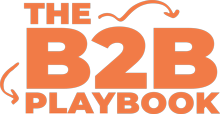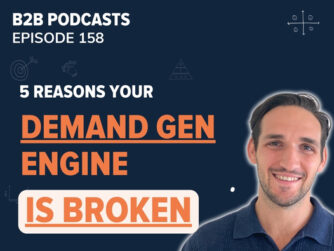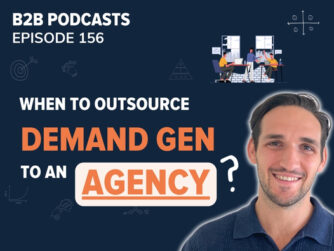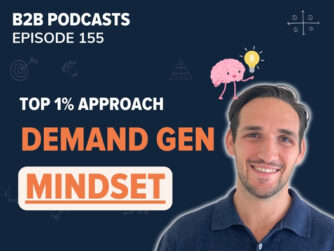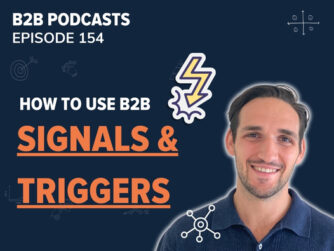Deeply understanding your customer and acting on insights could be the difference between life and death for a company. This sounds dramatic, but your customers are the North Star for your business.
Every time you make a decision without customer insights to inform it, you’re just guessing. And guessing wastes a LOT of time, energy a budget. But it seems as though most companies are reluctant to speak to their customers – for reasons we will explore later. Research from Bain & Company finds that as few as 22% of B2B companies consistently measure and act on their customers’ experience.
One of the best ways to understand your customers is to conduct Voice of the Customer research (VOC). To help us understand what it is and how to do it, we caught up with expert Alan Hale (President of Consight Markting Group).
Alan has been championing VOC Research for decades, and is a good friend of the podcast. In this definitive guide, we’ll dive into the intricacies of VOC research, exploring its impact on driving B2B demand, real-world success stories, and a practical framework for implementation – all through the lens of an industry expert.
As per usual, you can watch, read or listen to the best highlights with Alan.
Listen To The Episode
Watch The Episode
What is Voice of the Customer (VOC) Research?
VOC research encompasses comprehensively understanding customers’ stated opinions, perceptions, behaviours, likes and dislikes relating to all aspects of a company’s offerings and brand. It’s about gaining a holistic view of the customer perspective.
It’s a market research process that’s structured to ask questions, collect feedback, tabulate results, and take actions based on the data.
“It’s what the customers say, perceive and behave regarding your company, your brand, your product your service. Every, everything from what they like to don’t like.”
Alan Hale – The B2B Playbook
The insights you draw from the customer allows you to make better business decisions, minimise the risk of failing, and make it harder for the competition to copy your brand.
VOC Gives You an Outside In, not Inside Out Approach
Most companies have an inside out approach to their customers. They believe their own paradigm. They think they know what they’re doing. They think they know exactly what their customers want. In both Alan’s and my own experience, that’s a very difficult way to run a business.
Let me show you why with a great story that Alan shared with us.
“We were doing work for a laboratory testing equipment and they had a new gen product. It got stuck in the engineering design for about 14 months.
Alan Hale – The B2B Playbook
They were arguing which features to have. So we went out in the market [to ask them] and we narrowed it to 12 and out of those 12 features four of them were wanted, two of them were critical. And they were so critical, they’d pay extra for them.
They didn’t want the other features because it would make it too complicated and too costly. And then there was a set of features that they didn’t have on this next gen product that they wanted.
So what this allowed to do was have the engineers focus on what was necessary for the customers. Get it out of their department, launch it quicker, profits came quicker.”
If they didn’t use an outside in approach, they would have continued to spend hundreds of thousands of dollars of engineering time and getting nothing in return.
So you have to first determine what the customer needs and wants. Then you make sure your product or service fits that.
When To Use VOC Research?
Kevin and I believe that you should constantly be mining insights from your customers with VOC Research. But if you’re still not sure when to use it, it’s important to do it for any of these activities:
- product concept validation
- launching new products
- pushing into new marketings
- informing Go-To-Market strategies
- doing due diligence
- branding
- conducting win-loss analysis
- redoing your website
Really, anything that the customer touches should have customer input. At the end of the day, your job is not to ‘wow’ an engineer at your company. Your job is to get your Ideal Customer interested in your brand and product.
The 10/30/90 Rule for Voice of the Customer Research
Alan advocates for VOC research to be an ongoing, proactive process rather than just a one-off project. He proposes what he calls the “10/30/90 rule” to institutionalize customer obsession across the organization. As Alan states,
“One day, every two weeks, the marketing person needs to be in front of a customer and if they’re not, that’s marketing malpractice. You only get a certain number of those strikes and you get fired in my opinion.”
Alan Hale – The B2B Playbook – [00:10:20]
By requiring marketing to connect with customers every 10 business days, we ingrain that essential voice of the customer mindset.
The 30/90 components extend that philosophy to other functions. The other departments like engineering, new product development, customer service, they should be out every 30 days talking to a customer.
And then the CEO or the C suite, they should really each be assigned a platinum account or two and every quarter go see them. Having this cadence of customer touchpoints across the company reinforces the “outside-in” approach Alan touts. It prevents us from defaulting to the “inside-out” mentality of arrogantly thinking “we know our customers” that Alan cites as “the number one killer on company gravestones.”
Why Are Surveys So Limiting in B2B?
When most marketers are asked to gather customer insights, they lean into surveys. But surveys, while quick and cost-effective, often fall short in providing the deep insights necessary for effective B2B marketing. As Alan Hale points out,
“Surveys are very quick. They’re very cost-effective. They get numbers. Great. They don’t get insights”
Alan Hale – The B2B Playbook – [00:23:53]
The primary limitation lies in the lack of qualitative depth, which is crucial for understanding the underlying reasons behind customer opinions. Surveys are so different to having a one-on-one conversation. Surveys tell you ‘what’ happened, but they never give you the ‘whys’.
Also, surveys are so overused that it leads to survey fatigue from customers. This leads to diminishing response rates and fewer actionable insights.
To counter these limitations, Alan suggests using surveys to validate insights obtained through more in-depth qualitative methods like interviews and focus groups. This approach ensures a comprehensive understanding of customer needs and behaviours, enabling businesses to make informed strategic decisions.
How Do You Choose Which Customers To Speak To?
When it comes to voice of the customer (VOC) research, Alan Hale advocates following the 80/20 rule. As he states,
“We always start with…the client list, their top customers and descending value, right? And then we draw a line under the one that’s cumulative that makes up 80 percent of the revenue.”
Alan Hale – The B2B Playbook – [00:28:00]
By focusing initial VOC efforts on this top 20% of major accounts that drive 80% of revenue, we can extract maximum insight from “he who has the gold.”
Every organization has limited time, budget and resources. By focussing on our top accounts, we can dedicate our limited buget and resources to optimise our company to achieving better outcomes for them, and turning them into raving fans. This makes it easier for us to go-to-market and win more customers just like them.
This is why Alan emphasizes going deep with qualitative methods on these biggest customers.
An Insight to Alan’s Framework for VOC
Alan very kindly shared an insight into his own process for VOC. His framework emphasizes the importance of selecting the right methodology tailored to the specific needs and objectives of the business.
Objective-Driven Approach
First, you need to understand the customer’s objectives and how they will use the information gathered. This guides the choice of methodology.
Step-by-Step Methodology
- Ethnography: For designing a new product, ethnography involves observing customers in their environment to understand their needs better. (6-8 people should be okay)
- Focus Groups: These are useful for handling prototypes and gathering feedback in a controlled setting. (at least 8 people)
- Beta Testing: Engaging a team of beta testers from different customers to trial a product and provide feedback.
- In-depth Telephone Interviews: For customer satisfaction and loyalty studies, in-depth telephone conversations lasting 25-30 minutes are highly effective. (do this with the top 20% of customers – aim for 20 interviews if it’s not industry specific. Keep going until you see a dominant theme and a few minor themes.)
Once you pick the methodology, you need to figure out which job titles you need to talk to, to get the best insights from?
Make sure you start with your 80/20 analysis, so you’re drawing your insights from your top accounts.
Alan also tries to embed VOC in the organization’s DNA, following his 10-30-90 rule discussed earlier.
- Marketing Visits: Every two weeks.
- Other Departments: Every 30 days.
- C-Suite Visits: Quarterly (00:10:20) .
This continuous feedback loop ensures alignment and adaptation, fostering a customer-obsessed culture that can respond quickly to evolving needs and insights.
Practical Example of Applying VOC
So what does VOC Research look like in practice? Fortunately, Alan shared some detailed examples with us on how research can lead to real business insights and success. My favourite case study he shared involves a company based in the UK and Australia that sells a construction product for job sites.
Case Overview:
- Objective: The company wanted to enter the U.S. market.
- Market Sizing: The first step involved sizing the market to ensure their market share expectations were realistic.
- Competitive Analysis: They identified two major players controlling 50% of the market but realized these competitors had lower priorities due to acquisitions by larger companies focusing on higher-margin products.
Research Steps:
- Distributor Interviews:
- Alan’s team interviewed distributors to understand their sales to contractors.
- They asked about brand preferences and sales volumes, finding that contractors often asked for well-known brands like asking for “Kleenex,” but were not particularly loyal.
- Traffic Light System:
- Distributors were categorized using a “traffic light system” (red, yellow, green) to prioritize engagement based on their sales potential.
- This helped in identifying the most promising distributors to target first
- Contractor Feedback:
- Interviews with contractors revealed preferences for specific product features.
- Alan noted, “When our client came out, it was like night and day, what they designed an innovation. It was pretty, it wasn’t a dull grey. It had hydraulic hinges. It didn’t just slam on you” (00:44:30).
Outcome:
- The insights gathered from VOC research allowed the company to make design changes that resonated with the market.
- The company’s innovative product features differentiated it from competitors, leading to faster market acceptance and higher sales.
- Six months after launch, the CEO reported exceeding sales projections, validating the effectiveness of the VOC approach (00:45:00).
Such a great example from Alan! It shows how VOC research, including market sizing, competitive analysis, distributor prioritization, and direct customer feedback, can drive successful market entry and product adoption. The methodical approach made sure that the company’s strategy was deeply informed by real customer needs and market conditions.
What To Do With Your VOC Research To Make It Worth It
Once the Voice of the Customer (VOC) research is completed, Alan recommends several key action steps to make sure the insights are actually utilized, and drive meaningful change in the organization.
- Presenting the Findings
- Summarize the key insights and present them to senior management.
- Highlight the top three to five issues that are under the company’s control and actionable.
- Developing Initiatives
- Based on the insights, develop specific initiatives to address the identified issues.
- Prioritize these initiatives based on their impact on customer satisfaction and business performance.
- Creating a Feedback Loop
- Go back to the customers who participated in the research to validate the findings and proposed actions.
- Ask if there is anything missing and if the proposed plans align with their expectations.
- Implementing the Plan
- Execute the initiatives and monitor their progress regularly.
- Set up quarterly reviews to assess how well the plan is being implemented and make adjustments as necessary.
- Building Customer Relationships
- Regularly communicate with customers to show that their feedback is being taken seriously and acted upon.
- This builds trust and strengthens the customer relationship.
- Rinsing and Repeating
- VOC research should be an ongoing process, not a one-time project.
- Conduct VOC research regularly (e.g., every 12 to 18 months) to ensure the company stays aligned with customer needs and expectations.
Remember – without taking action, these insights will forever remain an ‘expense’ on your budget, when really they’re absolute gold.
Next Steps
If you would like to conduct VOC Research in your business, make sure you follow Alan Hale on LinkedIn, or contact him at Consight Marketing Group.
If you would like to have a go at ‘doing it yourself’, we go through questions to ask as part of customer research in our 12 week Demand Generation Course, The B2B Incubator. Check that out here.
